Current Northern Ireland skipper, Steven Davis, has spoken out about his future. He pledged his commitment to his current club, Rangers, and country, Northern Ireland, remaining coy about how long for exactly. Furthermore, he expressed his desire to get involved in football from a coaching perspective, with aspirations of managing both sides in the future. With that in mind, this piece will reflect on Davis’s career and show how he continues to influence the international scene.
Making his full debut under Lawrie Sanchez in 2005, Davis would go on to appear another 116 times for his country, amassing 117 caps in total, two off Pat Jennings, Northern Ireland’s most capped player record.
The Cullybackey man captained his country during the Euro 2016 finals, which was the first appearance at a major finals for the nation. To date, Davis has scored 12 times and assisted six for Northern Ireland. He started as a left midfielder before establishing himself as an influential player in the centre of the pitch. It was in this position were Davis found his identity, winning the IFA International player of the year in 2015 and 2016.
This scout report will better inform the reader of Davis’s strengths and
weaknesses. It will provide and make use of his statistics from this season. By doing so, we can develop an objective foundation that will allow for an accurate tactical analysis and evaluation of his ability.
Positioning
The former EPL player, featured primarily as a central midfielder for Northern Ireland. However, O’Neill, now in charge of EFL Championship side, Stoke, often tinkered with his midfield tactics. As a result, Davis has also featured as a defensive and attacking mid.
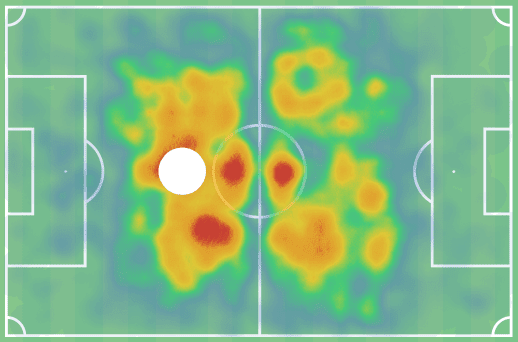
The role the analysis will examine is his most influential, and that’s as a central midfield. Acting as their ‘Maestro’, he’s responsible for the tempo of the match and shape of the team.

Let’s examine his positioning at set-pieces. The picture above shows Steven Davis’s role during defensive free kicks. The captain positions himself in-line with the front post. Here, he’s responsible for clearing low crosses as well as pressing any attempts to play short.

At attacking free kicks, Davis occupies a space on the edge of the box. If the opposition clears the initial cross, his positioning prompts an opportunity to recover possession. If he succeeds, his vision combined with world-class technique enables him to find a teammate or shoot.
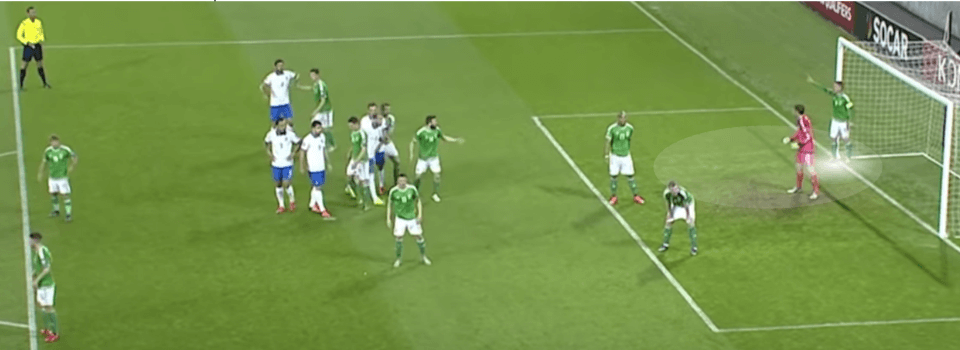
Above, at defensive corners, Davis takes a post. Therefore, his job requires him to clear any imminent danger. Furthermore, he leads the defensive line forward as they relieve the threat. As a result of him doing the job successfully, ‘and Davis clears it off the line again!’ is a phrase which Northern Irish supporters have become accustomed to over the years.
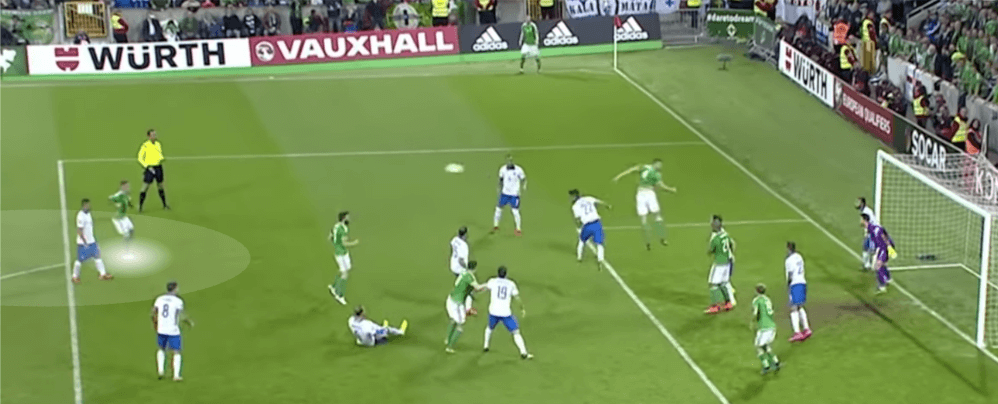
At attacking corners, Davis occupies a similar role as he does for attacking free kicks. His intense pressing style merging with his crossing or long-range shooting ability is a threat to any team’s defence. Above, Davis anticipates a clearance. He heads the ball back into the danger zone and in this case, into the back of the net. 3-0!
Build-up
Throughout his international career, Davis has been entrusted to drop deep, create an overload and establish possession amongst the defensive unit. By doing so reliably, he allows his fellow midfielders and full-backs to push higher up the pitch. Michael O’Neil made the most of this ability by playing direct and closing the loose ball down with the higher midfielders.
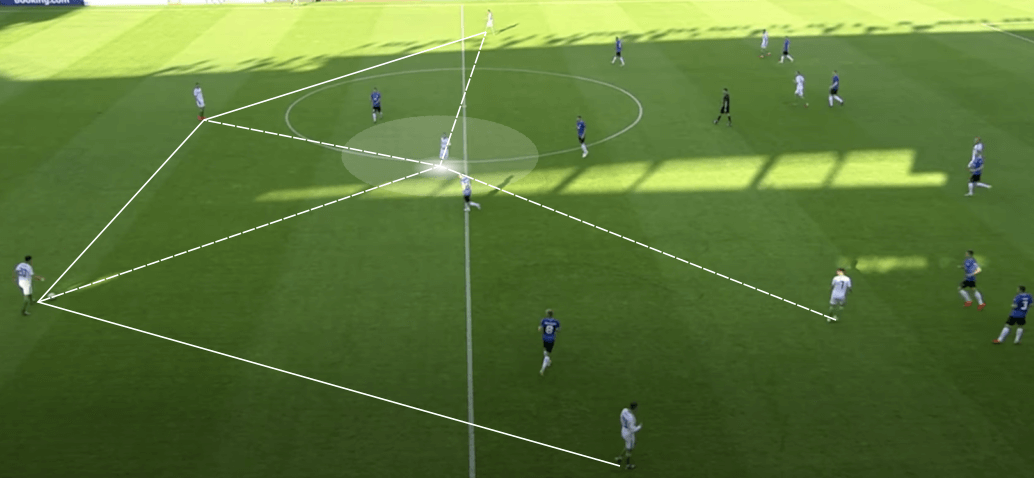
In the picture above, note how Davis provides an option, positioning himself in a space to receive and pass. His availability creates an overload in the middle third. As a result, Northern Irelands defenders have more options to pass too, making it easier to maintain possession. Furthermore, Northern Ireland’s reliability in possession allows their teammates off the ball to advance.
Progressing through the thirds
Under O’Neil, Davis plays as a pivot. He progresses through the middle third by playing around or over the opposing midfield unit. Additionally, when Northern Ireland utilise the long ball tactic, Davis will press to win the second ball as another method of progressing through the middle third.
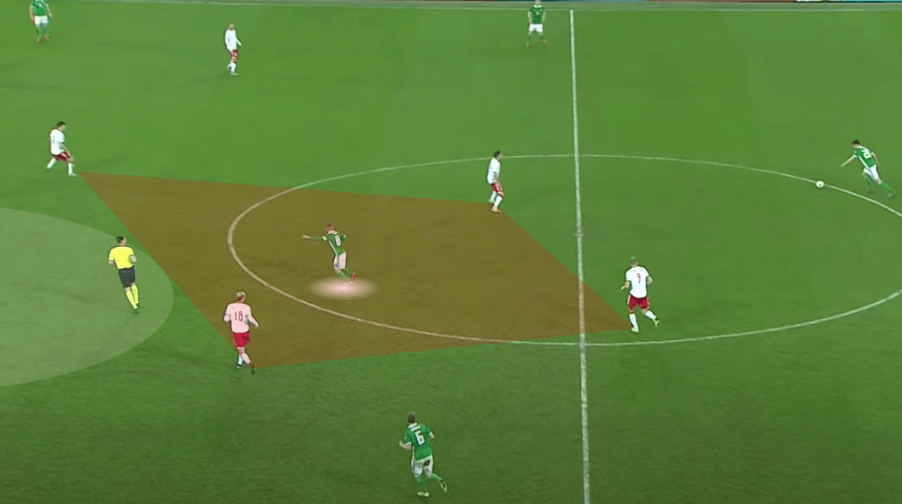
Above, notice how Davis instructs Craig Cathcart to play through. In this picture, the opponents prevent the pass through the middle to Davis. Therefore, Cathcart plays over the forward line. Davis and his two other midfielders will press to win the second ball as Josh Magennis, Northern Irelands striker, competes for the aerial duel.
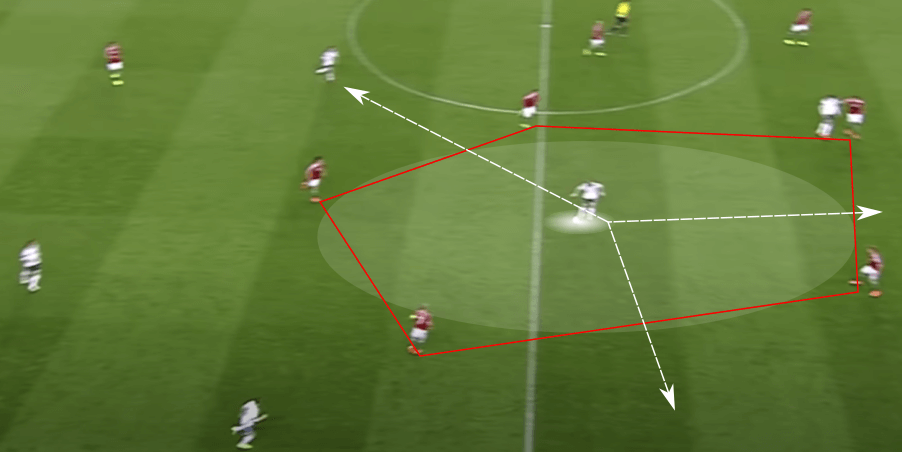
The example above shows alternative methods of progressing play by Davis. Using his spacial awareness, he drops into a space where he can receive and turn. Unable to play forward, Davis has the technical ability to evade the defenders and play the ball wide, allowing his teammates to carry the ball forward.
Another approach that Davis exercises to progress play is the long ball. For example, if Davis receives the ball in a deeper position near his defensive line, he will utilise his long-passing ability to unlock spaces in behind defences for his forwards to exploit (Imagine how a quarterback is used in American Football).
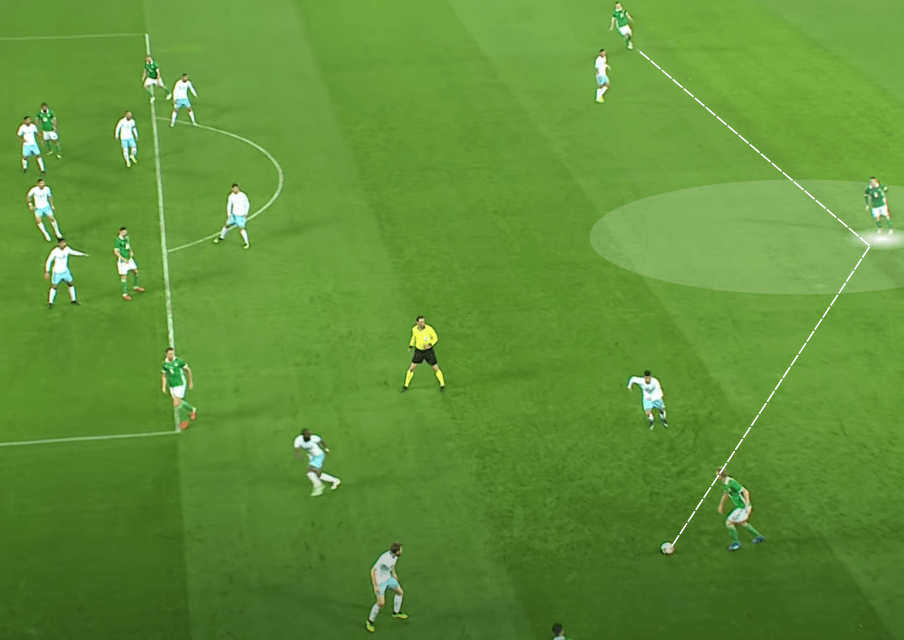
As the ball progresses into the channels, the closest midfielder, George Saville, supports play. Saville receives the pass and Davis provides a passing lane infield. If the opposition recovers possession, the captain’s position prevents the opponents from exposing his fellow centre-backs. He acts as the first line of defence, delaying the ball carrier, providing time for his teammates to recover.
Final third
Over the past 15 years, Davis has been instrumental for Northern Ireland in the final third. His vision, timing and ball manipulation have been responsible for some of their most paramount of victories.
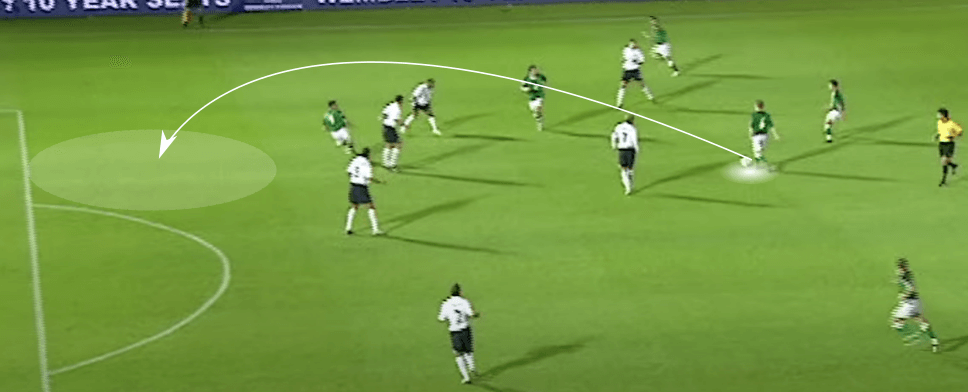
The example above shows a 20-year-old Davis executing the type of pass that’s become synonymous with his style of play. From an almost static position, he dinks the ball over the defensive line as David Healy makes a lead. Davis puts enough behind so that it reaches the target instead of falling short or ending up in the keepers grasp. Thus, highlighting Davis’s vision, timing and mastery of passing.
To date, Davis continues to provide key-passes. However, as of 2019, his deeper position in midfield has limited the number of attacking opportunities Davis gets.
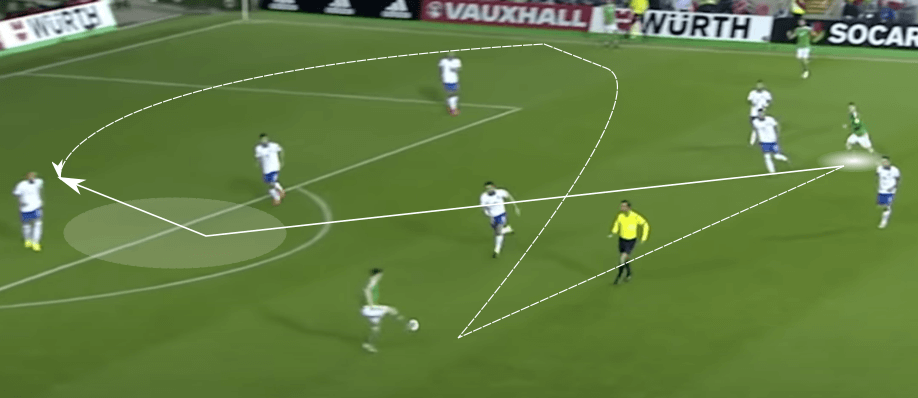
Furthermore, Davis visually identifies dangerous spaces to take up in the final third. Above, with Northern Ireland needing a goal to qualify for the European Championship 2016, Davis makes a pass infield to Cory Evans. Josh Magennis, the striker that day had drifted out left, leaving a space in the centre for a midfielder to fill. Davis spots this and makes his move as Evans distributes play out right. As a result, Davis enters the box at speed, tapping in a cross from the right to make it 1-0.
Defending from the front
Northern Ireland more times than not take a defensive approach going into most matches. As a result, Davis is part of a resilient middle block that has claimed 27 clean sheets from 71 games since Michael O’Neil started the job.

Above, Davis is part of a tight midfield unit that forces teams to play around or over them. The attributes that make him stand out in this position is his consistent concentration, communication and work rate to maintain shape throughout the game.
Defending the final third
As a defensive midfielder, Davis’s role includes marking the oppositions attacking midfield. If the opponent plays without an attacking midfielder, Davis will block the passing lane into the striker. He will also cover the space between the penalty spot and the edge of the box.
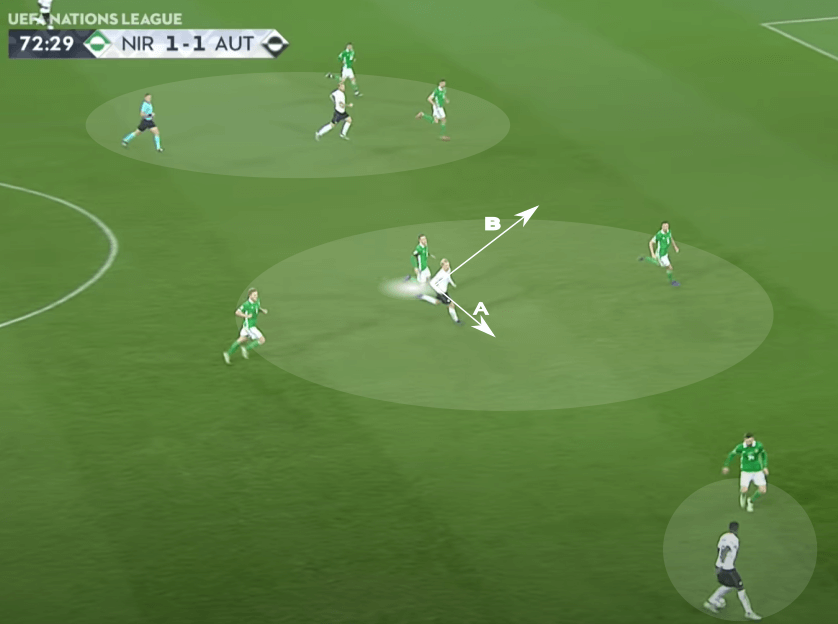
In the example above, Davis’s hard-working mentality enables him to remain tight to his opposite number. Note how his position permits him to see both the ball and the man he’s marking. Davis pursues the central runner and can make a challenge should it be passed in this direction. Failure to track his man or get on the wrong side could leave his centre-back exposed to a one on one situation.
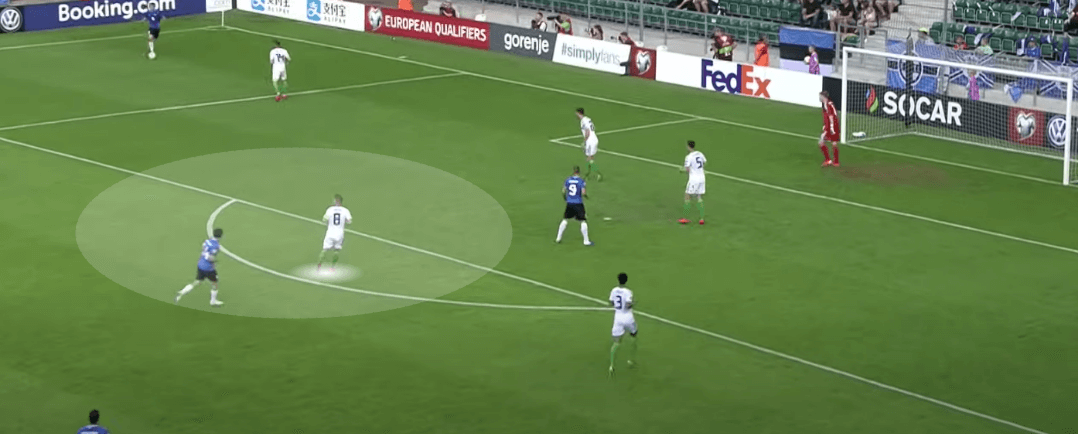
See above, the position Davis takes up in his box. At 35, Davis consistently treks back and marks the space in and around the penalty area. Moreover, he’s composed and disciplined in the defensive third. Despite the deafening atmosphere at the National Stadium, Davis can instruct his teammates. In a scenario where the ball enters the box, Davis instinctively deals with it without a second thought. Alternatively, when a player carries the ball into the box, Davis presses without diving in or going to ground. And finally, Davis makes sure to get himself between the ball and his marker. As a result, he always has a chance of intercepting the pass.
Conclusion
Over the past 15 years, Davis has provided hope for the Northern Irish natives. His commitment, professionalism and passion have contributed to his long and fruitful international career. With Davis looking set to become Northern Irelands most capped player of all time this report has tried to provide a reasoning as to why.
Beginning as an attacking midfield, he’s been able to evolve his game, becoming a quality centre midfielder that controls possession under immense pressure. Additionally, he works relentlessly, organises the shape in midfield and provides a screen for the defence.
Furthermore, when you thought he could do no more for his nation, he has recently spoken out about his desire to one day manage Northern Ireland. A loved and loyal servant, I wish him the best should he pursue it.






Comments